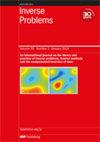Quantitative passive imaging by iterative holography: the example of helioseismic holography
IF 2
2区 数学
Q1 MATHEMATICS, APPLIED
引用次数: 0
Abstract
In passive imaging, one attempts to reconstruct some coefficients in a wave equation from correlations of observed randomly excited solutions to this wave equation. Many methods proposed for this class of inverse problem so far are only qualitative, e.g. trying to identify the support of a perturbation. Major challenges are the increase in dimensionality when computing correlations from primary data in a preprocessing step, and often very poor pointwise signal-to-noise ratios. In this paper, we propose an approach that addresses both of these challenges: it works only on the primary data while implicitly using the full information contained in the correlation data, and it provides quantitative estimates and convergence by iteration. Our work is motivated by helioseismic holography, a well-established imaging method to map heterogenities and flows in the solar interior. We show that the back-propagation used in classical helioseismic holography can be interpreted as the adjoint of the Fréchet derivative of the operator which maps the properties of the solar interior to the correlation data on the solar surface. The theoretical and numerical framework for passive imaging problems developed in this paper extends helioseismic holography to nonlinear problems and allows for quantitative reconstructions. We present a proof of concept in uniform media.通过迭代全息技术进行定量被动成像:日震全息技术实例
在被动成像中,人们试图从观测到的波方程随机激发解的相关性中重建波方程中的某些系数。迄今为止,针对这类逆问题提出的许多方法都只是定性的,例如,试图确定扰动的支持度。面临的主要挑战是,在预处理步骤中计算原始数据的相关性时,维度会增加,而且点信噪比往往很低。在本文中,我们提出了一种解决这两个难题的方法:它只适用于原始数据,同时隐含地使用相关数据中包含的全部信息,并通过迭代提供定量估计和收敛。我们的工作源于日震全息法,这是一种用于绘制太阳内部异质性和流动图的成熟成像方法。我们的研究表明,经典的日震全息法中使用的反向传播可以解释为将太阳内部特性映射到太阳表面相关数据的算子的弗雷谢特导数的邻接。本文针对被动成像问题开发的理论和数值框架将日震全息法扩展到非线性问题,并允许定量重建。我们提出了在均匀介质中的概念验证。
本文章由计算机程序翻译,如有差异,请以英文原文为准。
求助全文
约1分钟内获得全文
求助全文
来源期刊

Inverse Problems
数学-物理:数学物理
CiteScore
4.40
自引率
14.30%
发文量
115
审稿时长
2.3 months
期刊介绍:
An interdisciplinary journal combining mathematical and experimental papers on inverse problems with theoretical, numerical and practical approaches to their solution.
As well as applied mathematicians, physical scientists and engineers, the readership includes those working in geophysics, radar, optics, biology, acoustics, communication theory, signal processing and imaging, among others.
The emphasis is on publishing original contributions to methods of solving mathematical, physical and applied problems. To be publishable in this journal, papers must meet the highest standards of scientific quality, contain significant and original new science and should present substantial advancement in the field. Due to the broad scope of the journal, we require that authors provide sufficient introductory material to appeal to the wide readership and that articles which are not explicitly applied include a discussion of possible applications.
 求助内容:
求助内容: 应助结果提醒方式:
应助结果提醒方式:


